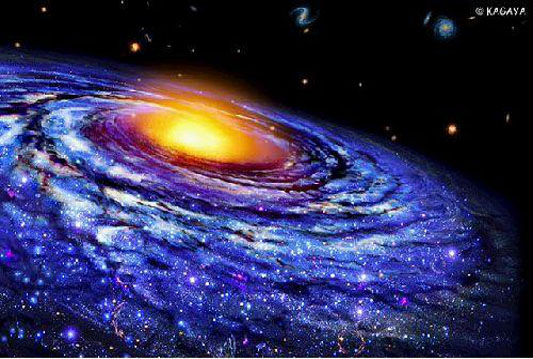(单词翻译:单击)
Altogether it is thought—though it is really only a guess, based on extrapolating from cratering rates on the Moon—that some two thousand asteroids big enough to imperil civilized existence regularly cross our orbit. But even a small asteroid—the size of a house, say—could destroy a city. The number of these relative tiddlers in Earth-crossing orbits is almost certainly in the hundreds of thousands and possibly in the millions, and they are nearly impossible to track.
据认为──虽然只是根据月球上形成凹坑的速度所作的一种推测,共有2000颗左右大得足以危及文明社会的小行星经常穿越我们的轨道。但是,即使是一颗很小的小行星──比如房子那么大小的小行星──也能摧毁一座城市。穿越地球轨道的比较小的小行星,几乎肯定数以十万计,很可能数以百万计,而它们几乎是无法跟踪的。
The first one wasn't spotted until 1991, and that was after it had already gone by. Named 1991 BA, it was noticed as it sailed past us at a distance of 106,000 miles—in cosmic terms the equivalent of a bullet passing through one's sleeve without touching the arm. Two years later, another, somewhat larger asteroid missed us by just 90,000 miles—the closest pass yet recorded. It, too, was not seen until it had passed and would have arrived without warning. According to Timothy Ferris, writing in the New Yorker, such near misses probably happen two or three times a week and go unnoticed.
第一颗有可能造成危险的小行星是1991年才被发现的。那是在它已经飞过去以后。它被命名为1991BA号;我们注意到,它在17万公里以外的地方跟地球擦肩而过──按照宇宙的标准,这相当于一颗子弹穿过我们的袖子而又没有擦破胳膊。两年以后,又有一颗较大的小行星险些碰着地球,只相差145000公里──这是记录到的最接近的一次擦肩而过。这一次也是在它飞过去以后才发现的,它在毫无预兆的情况下光临地球。蒂姆西·费里斯在《纽约客》杂志中写道,这样的擦肩而过每星期很可能要发生两三次而又不为人们注意。
An object a hundred yards across couldn't be picked up by any Earth-based telescope until it was within just a few days of us, and that is only if a telescope happened to be trained on it, which is unlikely because even now the number of people searching for such objects is modest. The arresting analogy that is always made is that the number of people in the world who are actively searching for asteroids is fewer than the staff of a typical McDonald's restaurant. (It is actually somewhat higher now. But not much.)
一个直径为200米的物体,要等到它距离我们还有几天的时候,地球上的天文望远镜才能发现,而且恰好是那台望远镜对准它,这是不大可能的,因为即使现在,在搜寻这类物体的人也为数不多。人们总是作这样的类比:世界上在积极寻找小行星的人数,还不及一家典型的麦当劳快餐店的职工人数。(实际上,现在比这多了一些,但多不了多少。)


